Published in September 2020, The Minor Railways of East Anglia describes some of the minor railways of the region that were once busy transport links and made vital contributions to the social life and businesses of the area they served. It also describes how some of the track beds that have survived have been restored as heritage railways, footpaths, or cycleways.
This hardback book from publishers Pen & Sword and written by John Hodge & Ray Caston measures around 21.59 cm x 27.31 cm, has 144 pages, and 200 colour and black and white illustrations. It has a published price of £.25.00 and at the time of writing Pen & Sword has it on offer for £17.50 and it can be obtained from Amazon for £19.02.
The book is split into five parts, with Part 1 “Definitions” discussing where is East Anglia, what exactly is meant by the term ‘Minor Railway’, and what was the Great Eastern Railway’s influence in the region.
Part 2 “Development” describes some but not all of the region’s minor railways, a major omission being the Wisbech and Upwell Tramway. Although only nine minor railways are described, they are further sub-divided into groups that the author considered to be each railway’s main purpose: “Railways for Maritime produce and perhaps for tourists”, “Railways for agricultural produce and passengers”, “Railways for industry”, and “Railway companies in competition – two stations to serve one location”.
Included in the Railways for Maritime produce and perhaps for tourists section are the Kings Lynn Harbour and Docks Railways, Great Yarmouth and Lowestoft Docks Railways and Southwold Harbour, and the Kelvedon, Tiptree and Tollesbury Light Railway
Railways for agricultural produce and passengers include the Three Horseshoes to Benwick Branch, the St. Ives Loop and Long Stanton Station, the Elsenham to Thaxted Light Railway, and the Denver, Stoke Ferry & the Wissington Railway.
Railways for industry describe the Leiston Works Railway, Snape Maltings, and the Barrington Cement Works Railway, whilst Railway companies that were in competition where two stations served one location includes Ramsey, Fakenham, Cromer and Haverhill.
I could not understand why there was a need to consider the railways in Part 3 ‘Demise – And Possible Recovery’ separately, especially given the part’s subtitle of ‘No more a ‘Common Carrier’? Economics? Social changes? A public service?’ as most of the lines in the book are no more. The lines in this part include the Great Chesterford to Newmarket Railway, the Mildenhall Branch, the Aldeburgh Branch, the Mid-Suffolk Light Railway, and the Halesworth to Southwold Railway.
Although this book is titled as being about minor railways, some of the chapters, especially the ones about King’s Lynn and Great Yarmouth are mainly about the towns themselves with only small references to their railways. Several chapters seem to concentrate more on the towns’ waterways and harbours rather than their railways, so much so that I feel the book should be titled Harbours of East Anglia and the railways that served them.
Throughout the book, the author seems to get side-tracked from the subject of minor railways, such as the page on the left below where he discusses the merits of various harbours. The map on the opposite page is captioned as showing railways to and from King’s Lynn, but it only shows railways around the actual docks area and their owning companies.
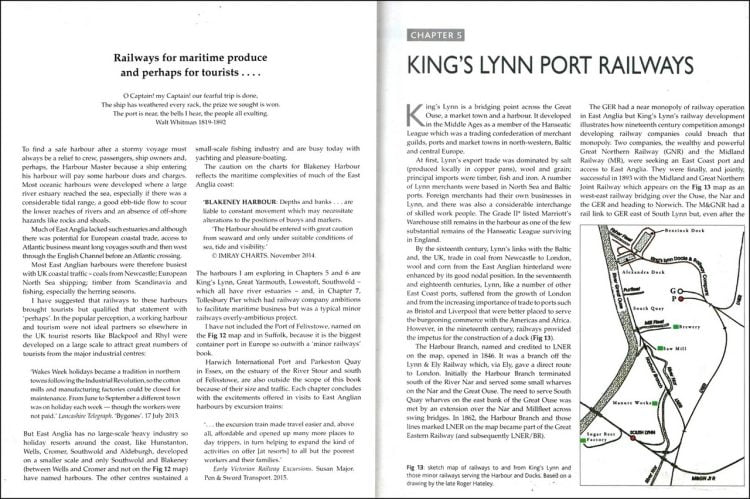
The caption to the map on the left-hand page below states it is an extract from a 6-inch OS map of Norfolk, but fails to state the actual location. It could be Great Yarmouth or Lowestoft because this chapter covers both of those locations.
The photos on the right are characteristic of many topics in the book, showing the towns themselves rather than the actual railways. Moreover, the photo at the top right is captioned ‘Railcar at Yarmouth’, which must be the first time one has been used on a log flume.
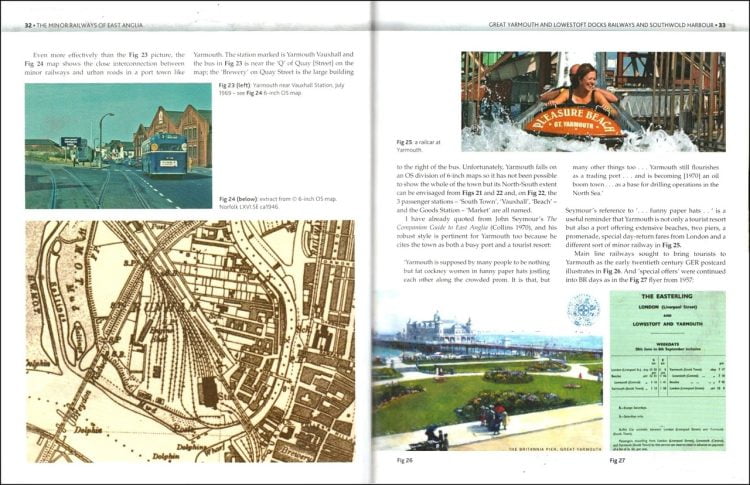
As in the previous pages, the photos below show locations in the town that have no railway connection at all. The text throughout this chapter has extensive coverage of the development of Lowestoft Harbour, and later in the chapter extensive coverage of Southwold Harbour. Within the 18 pages of this chapter, there is no more than a total of one page devoted to the area’s railway.
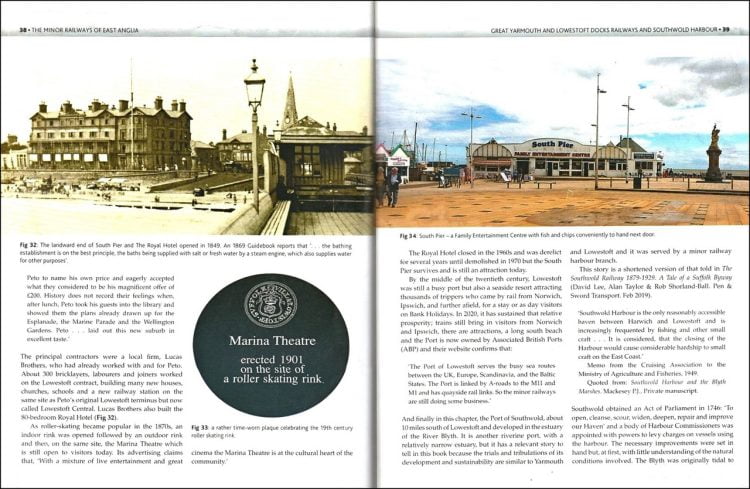
The map on the right-hand page below purports to show the whole of the railway from Kelvedon to Tollesbury. However, it is so poorly reproduced that it is illegible, Also the author has decided to tilt the map so that it fits on the page, but in doing so has lost its geographic sense.
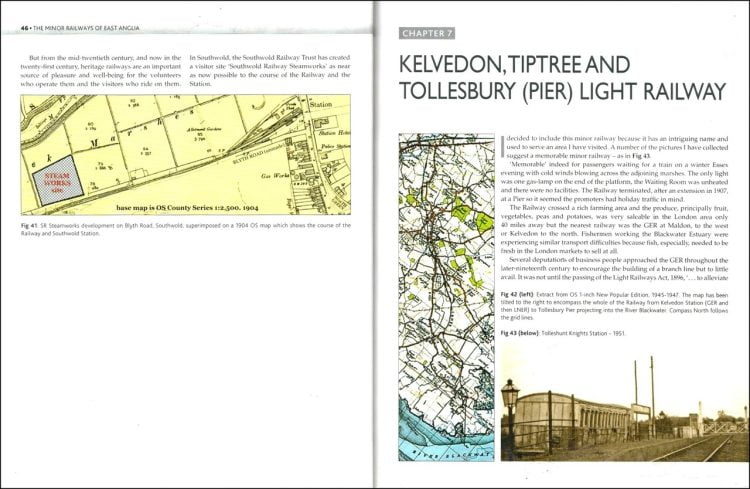
The left-hand page below is part of the Benwick branch chapter. A map accompanying the chapter shows that the were six stations or halts on the line, but other than being marked on the map, the text makes no reference to them at all or provides any information about the line’s motive power. On the right-hand page is a map titled “Railways in the Cambridge and March District”, and despite being the main railway centre in the area, March is completely missing from the map as it is five miles beyond the map’s upper limit. Also, the caption states that Chatteris is not marked on the map, but surely that would have been a simple addition to make before the book was published.
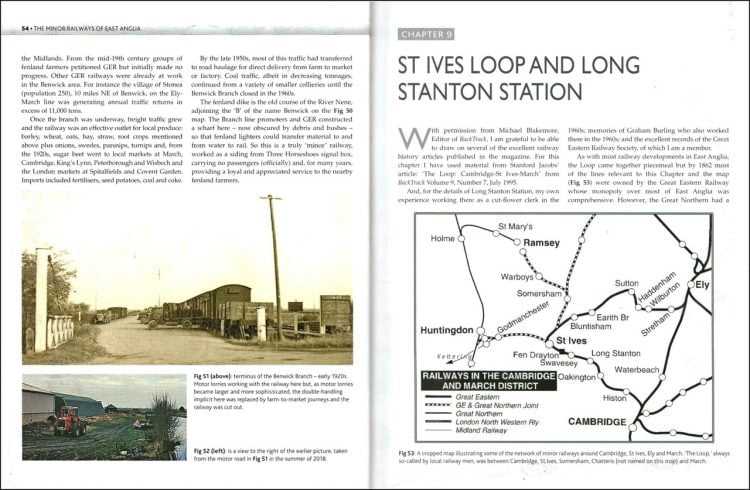
The pages below are from the Aldeburgh Branch chapter. However, like several other chapters in the book, it lacks a route map other than the extract from an OS map seen below. This covers the village of Thorpeness but completely ignores the rest of the line from Saxmundham Junction or the terminus at Aldeburgh. Also, like many other illustrations in the book, it has been coloured sepia which makes an indistinct map even more difficult to read.
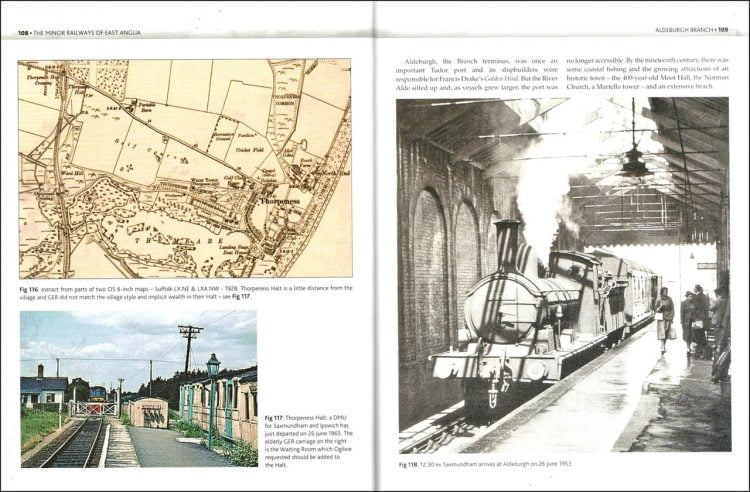
In summary, right from the first page, I got the impression that the author didn’t understand the book’s potential readership. Two pages of acronyms include many pointless entries, such as ‘mixed train’ means ‘mixed train’, ‘the Grouping’ means ‘the Grouping’ and ‘Vanfit’ means ‘Vanfit’
According to the book’s title, it describes the minor railways of East Anglia, but the organisation of the book is far from straightforward. The first part includes a whole-page discussion on the location of East Anglia when even a single sentence would have been overkill. There follows four pages explaining what exactly is meant by the term ‘Minor Railway’ when it is reasonable to assume that most purchasers of the book would completely understand the term, whilst five pages discussing the Great Eastern Railway’s influence in East Anglia adds nothing to the stories of the lines themselves.
Little thought seems to have been given as to what railways to include, as there are chapters on a branch line from Three Horseshoes to Benwick, whilst the St. Ives Loop and Long Stanton Station section is a description of an alternative route rather than a minor railway. Set against the inclusion of those lines, it seems inconceivable that the author has omitted a description of the Wisbech and Upwell Tramway, Colne Valley and Halstead, and Framlingham to Wickham Market lines.
Another major omission is the complete absence of what type of motive power was used on the lines, where the locomotives were maintained, how often passenger services ran, and with a few exceptions, the type of freight traffic that was carried.
Many photographs seem to have no railway connections, whilst the last photograph in the book, for some reason, shows a passenger train in India. Some of the maps do not show the locations covered by the chapter, are often indistinct, and their captions include details of which OS map was used but omit to state what their locations are. Recommended for anyone who wishes to expand their knowledge of the lines covered and the region’s harbours.
The book is available to purchase from Amazon and Pen & Sword.
We would like to thank Pen & Sword for providing RailAdvent with a copy of the book for review.





Responses